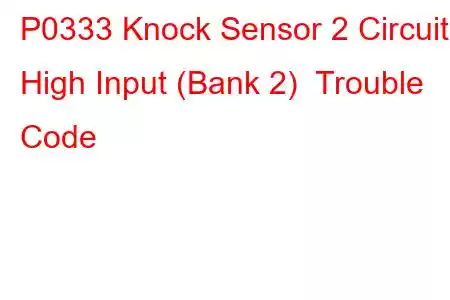P0333 Knock Sensor 2 Circuit High Input
OBD-II Trouble Code Technical Description
Knock Sensor 2 Circuit High Input (Bank 2)
What does that mean?
This diagnostic trouble code (DTC) is a generic powertrain code, which means that it applies to OBD-II equipped vehicles. Although generic, the specific repair steps may vary depending on make/model.
Knock sensors are used to detect engine pre-detonation (engine knock or ping).
The knock sensor (KS) is usually a two wire sensor. A 5 volt reference is supplied to the sensor and there is a signal return from the knock sensor to the PCM (powertrain control module). The sensor signal wire informs the PCM when a knock occurs and in what degree of severity. The PCM will retard the spark timing to avoid pre-detonation. Most PCMs have the ability to learn spark knock trends in the engine during normal operation.
A P0333 code is a generic DTC, thus it applies to all makes of vehicles, and refers to a high output voltage of the knock sensor. In many cases, this means the voltage is above 4.5V but that specific value depends on the specific make and model of vehicle. This code refers to the sensor on bank #2 (the side of the engine that doesn't contain cylinder #1).
Symptoms
Symptoms of a P0333 DTC may include:
MIL (Malfunction Indicator Lamp) illumination Audible knocking from the engine compartment Pinging from engine under acceleration Loss of power Irregular RPMCauses
Potential causes of a P0333 code include:
Knock sensor connector is damaged Knock sensor circuit is open or shorted to ground Knock sensor circuit is shorted to voltage Knock sensor has failed Loose knock sensor Electrical interference in circuit Low fuel pressure Incorrect fuel octane Mechanical engine problem Failed/faulty PCMPossible Solutions
If you can hear engine knock (detonation), first fix the source of the mechanical problem and retest. Ensure the correct octane fuel was used (some engines require premium fuel, check the owners manual). Aside from that, for this code, most likely the problem will lie either with the knock sensor itself or the wiring & connectors going from the sensor to the PCM.
Realisitcally, for the DIY vehicle owner, the best next steps are to measure the resistance between the two knock sensor wire terminals where they go into the PCM. Also, check the voltage of the same terminals. Compare those numbers to the manufacturer's specifications. Also, check all wiring and connectors leading from the knock sensor back to the PCM. In addition, you should also check the resistance using a Digital Volt Ohm Meter (DVOM) of the knock sensor itself, compare it to the vehicle manufacturers specification. If the knock sensor resistance value is out of spec, then it needs to be replaced.
Other knock sensor DTCs include P0324, P0325, P0326, P0327, P0329, P0330, P0331, P0332, P0333, P0334
Read: 45


